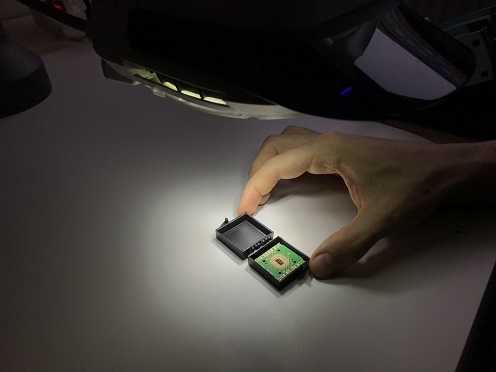Young researchers from QDev have created a promising component for future quantum computers
Two young researchers from the DNRF’s Center for Quantum Devices (QDev), post-doc Antonio Fornieri and Ph.D. student Alex Whiticar, are leading an international study and have developed a two-dimensional platform for quantum bits that are both stable and can be mass produced. This makes it a promising component for future quantum computers. The study has been published in Nature and is a collaboration between researchers from, among others, the University of Chicago and the Microsoft Quantum Lab at Purdue University.

Researchers across the world have long been challenged by the development of a so-called quantum bit that is stable enough for future quantum computers to perform complicated calculations before the quantum condition disappears and the information stored in the bits is lost. Now, a newly developed component looks promising for future quantum computers.
Post-doc Antonio Fornieri and Ph.D. student Alex Whiticar, from the Center of Excellence QDev at the Niels Bohr Institute, University of Copenhagen, are two of the leading forces behind the development of quantum bits – also known as qubits – that are both protected against disturbances and easy to mass produce. The newly developed component looks like it could be a solution to a hitherto unsolved problem in developing efficient quantum computers. The result has been published in the scientific journal Nature.
“A major advantage of the discovered component is that it can be mass produced. We can design a large and complex system of quantum bits on a contemporary laptop and have it manufactured using a common production technique for ordinary computer circuits,” said Fornieri, who is a post-doc at QDev and co-lead author behind the study.
Majorana quantum states are the foundation for the quantum computer being developed by the researchers from the Niels Bohr Institute. This quantum state has a special ability to protect itself from external disturbances, which makes it stable for a longer time than other types of quantum states.
Until now, Majorana particles have been created in the lab by researchers from QDev, among others, using semiconductor nanowires connected to superconductors and placed in a large magnetic field. But nanowires are not well suited for scale-up to a full-blown quantum technology because of the demanding labor-intensive assembly required: first, one must manipulate microscopic threads with a needle, then they must be moved individually from one substrate to another, and then secured into a network. This would be an exceptionally difficult process using hand-placed nanowires given that a quantum computer will likely require thousands or more bits. Furthermore, nanowires require high magnetic fields to function.
However, with the new quantum bit, the researchers can replace the nano threads with the new component, which is flat due to its two-dimensional platform, thus making it easier to handle. The new component also requires lower magnetic fields than the nano threads to achieve Majorana states.
According to Whiticar, a Ph.D. student at QDev, and the other co-lead author on the study, the promising quantum component has another advantage:
“Our component has an additional control parameter, in the form of the superconducting phase difference across the Josephson junction that makes it possible to simultaneously control the presence of Majorana states throughout a system of quantum bits. This has never been seen before. Furthermore, this system needs a much lower magnetic field to achieve Majorana states. This will significantly ease the manufacturing of larger quantities of quantum bits.”
To Fornieri, the structure behind the component is so promising that it may potentially be the basis for quantum bits that will be a part of quantum computers in the future:
“Our prototype is a significant first step towards using this type of system to make quantum bits that are protected from disturbances. Right now, we still need some fine-tuning – we can improve the design and materials. But it is a potentially perfect structure,” said Fornieri.
Read the scientific article in Nature here
More information about the study can be found in a press release from the Niels Bohr Institute here
